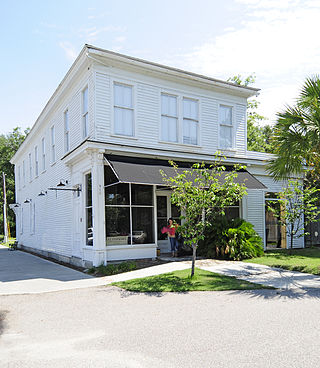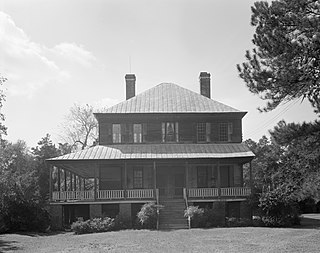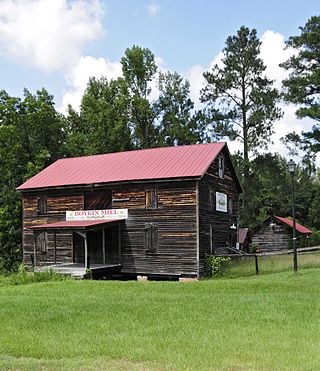
Berkeley County is a county in the U.S. state of South Carolina. As of the 2020 census, its population was 229,861. Its county seat is Moncks Corner, and the largest community is Goose Creek. After two previous incarnations of Berkeley County, the current county was created in 1882. Berkeley County is included in the Charleston-North Charleston, SC Metropolitan Statistical Area.

Pinopolis is an unincorporated community and census-designated place in Berkeley County, South Carolina, United States. As of the 2010 census it had a population of 948.

Hanover House is a colonial house built by a French Huguenot family in 1714–1716, on the upper Cooper River in present-day Berkeley County of the South Carolina Low Country. The house is also known as the St. Julien-Ravenel House after its early owners.

This is a list of the National Register of Historic Places listings in Berkeley County, South Carolina.

Mullins Commercial Historic District is a national historic district located at Mullins, Marion County, South Carolina. The district encompasses 38 contributing buildings in the central business district of Mullins. It includes an intact collection of late 19th and early 20th century commercial and other public buildings. The buildings illustrate the growth and development of Mullins from its beginnings as a railroad town to its prominence as the leading tobacco market in South Carolina for most of the 20th century. The buildings were constructed between 1895 and about 1945, and represent stylistic influences ranging from late Victorian period examples displaying elaborate brick-corbeled cornices and pediments to the more simplified and minimalist Depression-era examples with typical low relief detailing and vertical piers. Notable buildings include the Old Martin Hospital (1937), Vaughan Hotel (1921), Mullins Library (1941), Old Mullins Post Office, Bank of Mullins / Anderson Brothers Bank, and Mullins Depot (1901). Located in the district are the separately listed Old Brick Warehouse and J.C. Teasley House.
Orange Grove Plantation is a historic plantation house and national historic district located on Saint Helena Island near Frogmore, Beaufort County, South Carolina. The district encompasses one contributing building and two contributing sites, and reflects the early-20th century influx of Northerners onto St. Helena Island. The plantation was first recorded in 1753 when Peter Perry purchased 473 acres. Perry owned 46 chattel slaves. The plantation house, built about 1800, was in poor condition when Henry L. Bowles (1866-1932), a U.S. Representative from Massachusetts, bought the property in 1928. He demolished it and built the present house in the same year. The property also includes the tabby ruin of the kitchen, built about 1800, and a tabby-walled cemetery containing three early-19th century graves of the Fripp and Perry families.

F.W. Scheper Store is a historic general store located at Port Royal, Beaufort County, South Carolina. The store is one of the last remaining 19th century commercial buildings in Port Royal. It was built in 1885, and is a large two-story frame commercial building, with a one-story addition constructed between 1905 and 1912. It is the largest historic commercial building remaining in Port Royal. The store served the community from its construction by German immigrant F.W. Scheper until it closed for business in 1950.

Lawson's Pond Plantation is a historic plantation house located near Cross, Berkeley County, South Carolina. It was built about 1823, and is a large two-story clapboard structure set upon high foundations. It has a hipped roof and features a one-story piazza along the front and left facades.
Richmond Plantation, also known as Girl Scout Plantation, is a national historic district located near Cordesville, Berkeley County, South Carolina. It was built about 1927, and includes a manor house and outbuildings constructed as a hunting lodge for George A. Ellis, a prominent New York financier and co-founder of E. F. Hutton & Co.

William Robertson House, also known as Wampee Plantation Summer House, is a historic home located at Pinopolis, Berkeley County, South Carolina. It was built about 1844, and is a two-story, three-bay, frame I-House, sheathed in weatherboard. It features a hip roofed, one-story porch spanning the façade and wrapping around the right elevation. The house was one of the early planters' retreats in the pineland village of Pinopolis.
Cainhoy Historic District is a national historic district located near Huger, Berkeley County, South Carolina. It encompasses nine contributing buildings, which range in date from the mid-18th century through the early-20th century. They represent the development of the village from a ferry landing to a small but thriving river port. It was the site of America's first porcelain factory, established by John Bartlam in 1765. Each building is a vernacular specimen from its respective period, including the Federal style. Cainhoy's significance lies in its role as an early transportation link between inland Berkeley County and Charleston and in its fine collection of early buildings. In 1876, Cainhoy was the site of a political rally for Wade Hampton (1818-1902) which degenerated into a brawl between blacks and whites. Christened the "Cainhoy Massacre," the incident left seven men dead and sixteen wounded.
Pinopolis Historic District North is a national historic district located at Pinopolis, Berkeley County, South Carolina. It encompasses six contributing buildings on four of the 19th century retreats that helped to engender Pinopolis. The vernacular houses are uniformly of frame construction and abstain from the stylistic pretensions of the permanent planters' seats of the period in accord with their status as houses of retreat. The buildings in the district date from about 1834 to about 1883 and retain in large measure their original forms and features. The district's landscape is unified by the absence of contemporary buildings, heavy foliage, the absence of paved roads, and the cohesiveness of the four residences which are weatherboarded with large porches, reflecting the Queen Anne style.

Pineville Historic District is a national historic district located at Pineville, Berkeley County, South Carolina. It encompasses seven contributing buildings and illustrates Pineville's original role as a 19th-century pineland village, and its gradual transformation to agricultural land and to a year-round community in the late-19th and early-20th centuries. The Pineville Historic District consists of four principal buildings, three residential buildings and one Episcopal church, ranging in date from about 1810 through 1925. The architectural styles represented include Federal, Greek Revival, and Bungalow. In the mid to late-19th century, Pineville was a densely settled village that included as many as one hundred buildings, including an academy, racetrack, library, churches, and residences. Much of the town was burned by Union troops at the close of the American Civil War in April 1865. In the years following the war, much of the land that made up the village was converted for use as farmland. Since that time, Pineville has remained a small community of less than 20 structures surrounded by open farm and hunting lands.
Cooper River Historic District is a national historic district located along the East and West Branches of the Cooper River near Moncks Corner, Berkeley County, South Carolina. It encompasses 32 contributing buildings, 77 contributing sites, 8 contributing structures, and 4 contributing objects and is a remarkably intact historic and cultural landscape. The district includes many historic buildings, structures, and objects from the 18th, 19th, and 20th centuries and archaeological remains of settlements, machines, barns, and other structures that supported agricultural activity. In addition, there are landscape features dating to the 18th and 19th centuries such as rice fields, banks, canals, dams, reservoirs or reserves, causeways, roads, avenues, upland fields, fence lines, and cemeteries.

Gaffney Residential Historic District national historic district located at Gaffney, Cherokee County, South Carolina. The district encompasses nine contributing building and 1 contributing structure in Gaffney. The focal point of the district is the historic section of Limestone College campus. The campus includes the nine buildings constructed between about 1837 and 1941. The buildings on the campus are oriented towards a central lawn and fountain. The buildings are classically inspired and include architectural styles such as Gothic Revival and Neoclassical and also a meeting house form church. Also included in the district is a limestone quarry that was mined in the 19th and early-20th century and a mid-19th century church building. The limestone quarry is located adjacent to the historic section of the campus and the Limestone Springs Baptist Church is adjacent to the quarry. Notable buildings include the separately listed Winnie Davis Hall and Limestone Springs Hotel.

Manning Commercial Historic District is a national historic district located at Manning, Clarendon County, South Carolina. The district encompasses 46 contributing buildings and 1 contributing object in the central business district of Manning, county seat for Clarendon County. Manning's downtown is dominated by its 1909 Neo-Classical, red brick courthouse set at the center of a landscaped courthouse square. The commercial district is characterized by one- and two-part commercial block buildings, many of them brick, that were constructed during the late-19th and early-20th century. The buildings are characterized by oblique and angled entrances, intriguing decorative cornices and corbeling, and a preponderance of parapeted rooflines give the Manning Commercial Historic District a clear and unmistakable association with the architecture typical of the early-20th century. In addition to the courthouse, other notable buildings include the U.S. Post Office and Federal Building, Coffey-Rigby Livery Stable, Clarendon Furniture Store, Leonard Building, Manning Hotel, Brailsford Grocery / Schwartz Building, Cut Rate Drug Store, and Pure Oil Service Station.
Oaklyn Plantation is a historic plantation and national historic district located near Darlington, Darlington County, South Carolina. The district encompasses 40 contributing buildings, 6 contributing sites, 2 contributing structures, and contributing object. Founded as a forced-labor farm worked by black people enslaved by the land's white owners, it was one of the major plantation establishments of the county and served as the seat of the Williamson family for more than 200 years.
Murrells Inlet Historic District is a national historic district located at Murrells Inlet, Georgetown County, South Carolina. The district encompasses 37 contributing buildings and contains a significant concentration of buildings that visually reflect the transition of the area from adjoining estates of two 19th-century rice planters into a 20th-century resort community. The district contains two antebellum houses, which are local interpretations of the Greek Revival style and a collection of early-20th-century vernacular resort buildings. Residential in character, the historic district contains approximately 19 houses. Although they exhibit some diversity, the prevalent use of wood as a building material, the large screened porches, and the setting of moss-draped trees, marshland, and piers provide a visual unity.

Boykin Mill Complex, also known as Mill Tract Plantation, is a national historic district located near Camden, Kershaw County, South Carolina. The district encompasses nine contributing buildings, two contributing sites, and four contributing structures. “Boykin Mill” denotes a community which consists of an old post office, an old general store, a c. 1905 grist mill, mill pond, mill dam, gates, and canals. The community also includes an early 19th-century Greek Revival style Baptist church, one mid-19th-century residence, three 20th-century residences built for mill workers, and a smoke house. An American Civil War battle site is also a part of the Boykin Mill community. The Battle of Boykin's Mill took place on April 17, 1865.

Mount Pleasant Historic District is a national historic district located at Mount Pleasant, Charleston County, South Carolina. The district encompasses nine contributing buildings in the town of Mount Pleasant. The dwellings reflect Mount Pleasant's historic role as a summer resort town. The building reflect architectural styles of the 18th, 19th and early 20th centuries, including vernacular Georgian, Greek Revival and Gothic Revival. Notable buildings include the Mount Pleasant Presbyterian Church, St. Andrew's Episcopal Church, Mount Pleasant Seventh-Day Adventist Church, Hibben-McIver House, 200 Bank Street, and the Captain Peter Lewis House. Located in the district is the separately listed Old Courthouse.
















